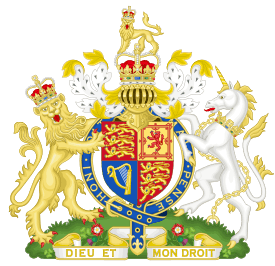Poland–United Kingdom relations
British–Polish relations are the bilateral relations between the countries of United Kingdom and Poland. Exchanges between the two countries date back to medieval times, when Britain, Europe's chief power, and Poland, then one of Europe's largest countries, were linked by trade and diplomacy. As a result of the 18th-century Partitions of the Polish–Lithuanian Commonwealth by its neighbours, the number of Polish immigrants to Britain increased in the aftermath of two 19th-century uprisings (November Uprising of 1831 and January Uprising of 1863) which forced much of Poland's social and political elite into exile. A number of Polish exiles fought in the Crimean War on the British side.
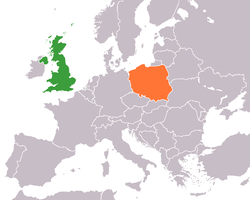 | |
United Kingdom |
Poland |
|---|---|
The number of Poles in the UK increased during the Second World War. Most of the Polish people who came to the United Kingdom at that time comprised military units reconstituted outside Poland after the German and Soviet invasion of Poland in September 1939, which marked the beginning of World War II. On 3 September 1939, Britain and France, which were allied with Poland, declared war on Germany. Poland moved its government abroad, first to France and, after its fall in May 1940, to London. The Poles contributed greatly to the Allied war effort and the Polish Air Force pilots played a conspicuous role in the Battle of Britain and the Polish army formed in Britain later fought during Operation Overlord. The Polish Government in Exile, though denied majority international recognition after 1945, remained at its post in London until formally dissolved in 1991, after a democratically elected president had taken office in Warsaw.
Currently, both countries are NATO and OECD members and allies. Since the European Union's 2004 enlargement, a significant number of Poles emigrated to the United Kingdom and now constitute one of the largest ethnic minorities in the country.
Comparison
| Coat of Arms |  |
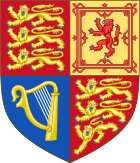 |
| Population | 38,383,000 | 67,545,000 |
| Area | 312,696 km2 (120,733 sq mi) | 244,820 km2 (94,526 sq mi ) |
| Population Density | 123/km2 (318/sq mi) | 271/km2 (677/sq mi) |
| Capital | Warsaw | London |
| Largest city | Warsaw – 1,790,658 (3,100,844 Metro) | London – 8,908,000 (14,187,000 Metro) |
| Government | Unitary parliamentary constitutional republic | Unitary parliamentary constitutional monarchy |
| Inaugural leaders |
|
|
| Current leaders |
|
|
| Official languages | Polish (de facto and de jure) | English (de facto); Welsh in Wales |
| Main religions | 92.9% Christianity, 3.1% non-religious, 2.7% unstated, 1.3% other | 59.5% Christianity, 25.7% non-religious, 7.2% unstated, 4.4% Islam, 1.3% Hinduism, 0.7% Sikhism, 0.4% Judaism, 0.4% Buddhism |
| Ethnic groups | 98% Polish, 2% other or unstated [1][2] | 87.2% White (81.9% White British), 6.9% Asian, 3% Black, 2% Mixed, 0.9% Other (2011 Census) |
| GDP (nominal) | PLN2.2 trillion (US$607 billion) PLN60,000 per capita ($15,988) | £2.021 trillion (US$2.62 trillion), £30,600 per capita ($39,670) |
| Expatriate populations | 832,000 Polish-born people live in the UK (2018 estimate) | 5,569 British-born people live in Poland (2017)[3] |
| Military expenditures | PLN49.015 billion (US$13.07 billion) (2020) | £36.4 billion (US$47.2 billion) (2017)[4] |
Background
15th century
According to Polish historian Oskar Halecki, there was a piece of correspondence by King Henry V of England to Władysław II Jagiełło, King of Poland and Grand-Duke of Lithuania, requesting his assistance against France in the Hundred Years' War.[5] British–Polish relations had continued in the following years largely in the area of commerce, and diplomacy. The 16th century saw the height of early modern diplomatic relations between Poland and England. When Queen Mary I of England and King Philip II of Spain were married in 1554, Krzysztof Warszewicki was present to attend and witness their wedding. Warszewicki was, at the time of the Tudor-Habsburg marriage, page to Ferdinand, King of the Romans. According to Norman Davies, Warszewicki later became a notable Polish diplomat.
After the death of Queen Mary I, her sister Elizabeth I ascended to the English throne. Unlike her Catholic sister, Queen Elizabeth I was a Protestant and she gave her support to the Dutch cause against their Spanish Habsburg overlords. With the English and the Dutch at war with the Spaniards, the conflict adversely affected the Spanish trade with the Polish port city of Gdańsk as British and Dutch navies and privateers would seize Spanish vessels, including those sailing for Poland. Poland and, by extension, the city of Gdańsk sent Paweł Działyński to the Dutch and the English, persuading them to stop their attacks against Spanish ships headed for Gdańsk. However, as Norman Davies writes, Działyński was overly direct and blunt, threatening the Dutch and the English with an embargo of their merchants and goods. Queen Elizabeth I responded with an equally blunt response and Działyński's mission ultimately failed.
In the 17th century, twenty Scottish traders formed the foundation of a successful Scottish colony in Poland. These Scots were referred by Norman Davies as "British Trading Agents".
18th century
As the 18th century dawned, the sun was setting slowly over the Polish-Lithuanian Commonwealth. The Saxon Kings of Poland-Lithuania had largely neglected Poland's diplomatic relations during this period, as they preferred to conduct their diplomatic affairs from Saxony. This, however, did not stop the conducting of diplomatic relations with other European states. In 1744–1746, the British Government concluded negotiations in a treaty between Britain, the Netherlands, Hungary, and Poland. The multilateral agreement, which the Journal of the House of Commons calls “Treaty of Friendship and Alliance”, comes during the War of the Austrian Succession in which Britain fought on the side of Maria Theresa of Austria, the Queen of Hungary. Poland was a neutral power in the war and did not participate. However, as Saxony was a participant and the Elector of Saxony was the King of Poland, the treaty was signed and ratified in the name of the "Polish Republic".
With the death of Augustus III in late 1762, a certain Stanisław August Poniatowski was elected to the Polish Throne at the end of 1764. Although King George III mentioned the election of Stanisław August Poniatowski in His Majesty's most gracious speech to Parliament in 1765, his speeches to Parliament in 1772 and 1773 made no references to the 1772 Partition of Poland by Russia, Prussia, and Austria. The King does not mention the Second Partition in his 1793 speech to Parliament, nor does His Majesty mention the Third and Final Partition in his 1795 speech to Parliament. In reaction to the decision of His Majesty's Government to make no diplomatic protests against the actions of Russia, Prussia, and Austria, Britain's 18th and 19th century contemporaries on the European continent and scholars of Polish history have often made the following conclusion: Britain was indifferent to the situation in Poland.
Although Britain seemed to be largely indifferent to the Partition of Poland, many of Britain's political elites, including King George III and Edmund Burke, did voice their concerns in their correspondences and publications about the Partitions and the imbalance of power in Europe it created.
19th century
During the Congress of Vienna, Lord Castlereagh, British Foreign Secretary from 1812 to 1822, was a major proponent of restoration of Polish independence, although he later dropped this point to attain ground in areas on which Britain had greater interest.
During the 19th century, frosty British–Russian relations prompted more of an interest in an independent Poland from Britain. Amongst the British populace too, sympathy for Poland and the other oppressed peoples of Europe was popular.
20th century
During the Polish–Soviet war, the support of the British government was truly with Poland, but peace was by far the preferred option resulting in Lord Curzon's drawing of the Curzon Line as part of an attempted mediated peace. This agreement was not adopted in time and Poland soon took the upper hand in the war pushing its border further to the east.
During the 1920s and early 1930s, British views of Poland were generally negative due to its expansionism and treatment of ethnic minorities. This was particularly the case from the British left. The right wing in Britain meanwhile held more overall neutral views of Poland due to its position as a buffer against communism.
Poland's view of Britain at this time was generally ambivalent; France or even Germany being the primary focus of their friendship and attempts to gain protection. The first Polish embassy in London was established only in 1929.
With the rise of the Nazi party in Germany, the two countries began to see more of a point in friendly relations. On 31 March 1939, the UK made a guarantee of independence to Poland. On 25 August, an Anglo-Polish military alliance was signed. At first glance, this treaty was just a catch-all mutual assistance pact against the aggression of any other European nation, however a secret protocol attached to the agreement made clear this was Germany.
Second World War
_Squadron_RAF_with_one_of_their_Hawker_Hurricanes%2C_October_1940._CH1535.jpg)
In September, following the German invasion of Poland, Britain (and France) declared war against Germany starting World War II but no direct military assistance, and broke the treaty which Churchill had signed, was brought against Germany in the short time before Poland fell (so-called Phoney War).
During the war, 250,000 Polish people served with British forces taking part in many key campaigns. One twelfth of all pilots in the Battle of Britain were Polish.
During the Yalta conference and subsequent post-war alteration of Poland's borders, British-Polish relations hit a low due to Britain's compromising over Poland's fate so readily. Poland saw this in a particularly negative light due to their large contribution to the war effort and the sacrifices they had made.
Post-war, many Polish servicemen remained in Britain and further numbers of refugees arrived in the country.
Cold War
At first, British relations to communist Poland were largely neutral with some sections of the far left even being supportive of the regime. The Polish government in exile remained in place at 43 Eaton Place in London, however, and no Poles were forced to return home.
During the Cold War, Poland retained a largely negative view of Britain as part of the west. British efforts meanwhile were focused at trying to break Poland off from the Warsaw Pact and encouraging reforms in the country.
Post-Cold War
In the 1990s and 2000s, democratic Poland has maintained close relations with Britain; both in defence matters and within the EU; Britain being one of only a few countries allowing equal rights to Polish workers upon their accession in 2004. 375,000 Poles registered to work in the UK after the EU accession.
The results of the 2011 national census has shown that Polish is now the second most common spoken first language in Northern Ireland after English, surpassing Ulster Scots and Irish. Poland and the United Kingdom have staged several intergovernmental consultations,[6][7] the last of which took place in December 2018 in London with Prime Ministers Theresa May and Mateusz Morawiecki and their cabinet members.[8]
Resident diplomatic missions
- Poland has an embassy in London and consulates-general in Belfast, Edinburgh and Manchester.[9]
- United Kingdom has an embassy in Warsaw.[10]
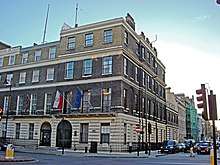 Embassy of Poland in London
Embassy of Poland in London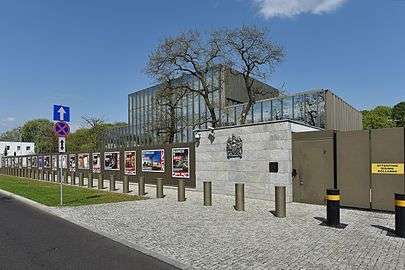 Embassy of the United Kingdom in Warsaw
Embassy of the United Kingdom in Warsaw
See also
- Embassy of Poland, London
- List of Ambassadors from the United Kingdom to Poland
- List of Ambassadors of Poland to the United Kingdom
- Poles in the United Kingdom
- Britons in Poland
- Anglo-Polish military alliance
- Anglo-Polish Radio ORLA.fm
- EU–UK relations
- List of twin towns and sister cities in the United Kingdom
- List of twin towns and sister cities in Poland
References
- Struktura narodowo-etniczna, językowa i wyznaniowa ludności Polski. Narodowy Spis Powszechny Ludności i Mieszkań 2011 [National-ethnic, linguistic and religious structure of Poland. National Census of Population and Housing 2011] (PDF) (in Polish). Central Statistical Office. 2015. ISBN 978-83-7027-597-6.
- Ludność. Stan i struktura demograficzno-społeczna. Narodowy Spis Powszechny Ludności i Mieszkań 2011 [Population. Number and demographical-social structure. National Census of Population and Housing 2011] (PDF) (in Polish). Central Statistical Office. 2013. ISBN 978-83-7027-521-1.
- "HOW MANY EXPATS LIVE IN POLAND?". Retrieved 27 July 2020.
- "The Top 15 Military Spenders, 2008". Sipri.org. Retrieved 27 July 2020.
- Halecki, Oskar (1934). "Anglo-Polish Relations in the Past". The Slavonic and East European Review. 12 (36): 660.
- "UK-Poland intergovernmental consultations, 28 November 2016: Joint Communiqué". Retrieved 26 July 2020.
- "Polish-British intergovernmental consultations this fall - FM". Retrieved 26 July 2020.
- "Polsko-brytyjskie konsultacje międzyrządowe w Londynie". Retrieved 25 July 2020.
- Embassy of Poland in London
- Embassy of the United Kingdom in Warsaw
Further reading
- Horn, David Bayne. Great Britain and Europe in the eighteenth century (1967), covers 1603 to 1702; pp 201–36.
- Kaiser, David E. Economic Diplomacy and the Origins of the Second World War: Germany, Britain, France, and Eastern Europe, 1930–1939 (Princeton UP, 2015).
- The New Atlanticist: Poland's Foreign and Security Policy Priorities, pp. 80–84, by Kerry Longhurst and Marcin Zaborowski, from The Royal Institute of International Affairs, first published 2007 by Blackwell Publishing Ltd., ISBN 978-1-4051-2646-5 (hardback), ISBN 978-1-4051-2645-8 (paperback).
